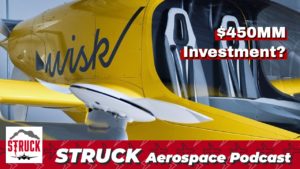In this episode we discuss the folding wing tips of the Boeing 777x airplane, and what this engineering feat means for the plane’s versatility. We revisit 737 Max troubles and discuss engineering testimony, plus dive back into the Otto Aviation Celera 500L and talk more about laminar flow and its claims of fuel efficiency. Lastly, we look at the AutoFlight V400 and talk through this EVTOL’s possibilities in the market.
Learn more about Weather Guard StrikeTape segmented lightning diverter strips. Follow the show on YouTube, Twitter, Linkedin and visit us on the web. Have a question we can answer on the show? Email us!
Podcast: Play in new window | Download
Transcript: EP27 – Boeing 777x Wing Tips, 737 Max Troubles, More Otto Celera 500L and AutoFlight V400 News
Dan: You’re listening to the struck podcast.
Dan: And here on struck, we talk about everything. Aviation, aerospace engineering, and lightning protection for aircraft radomes.
All right. Welcome back to the struck podcast. In today’s episode, we are going to cover a bunch of interesting topics. Number one. There was a recent, uh, engine fire causing a emergency landing with an . We’re going to chat a little bit about that. Uh, and our engineering segment, the 777X. So obviously Boeing’s had a lot of press recently, most of it bad, but we’re going to talk a little bit about the engineering and the 777X and they’re folding wind wingtips, which is pretty cool technology.
Uh, we’re going to chat more about the Boeing 737 max. Obviously the congressional report just came out today. We’re not going to touch on that in this episode, but we are going to talk a little bit about some of the executives and the D the D design process and their defense of it. And then we’re going to chat a little more about the Otto Celera.
500L – So the Otto aviation, they’re one of their really unique jets, um, uh, planes. Uh, they have some crazy efficiency claims. We touched on it last time. We’re going to chat a little bit more about it today. And then lastly, in our EVTOL segment, we’re going to talk about the Autoflight V400. Uh, which is a unique cargo, um, you know, electric vehicle that’s coming out of, and it looks like China and we will chat about it.
And as well as maybe the, some of the bigger models that auto flight is going to be spring off of that one. So, Allen, how are you, sir? Let’s jump right in the, had an engine fire this weekend. Uh, I was at American airlines or this week and American airlines, Airbus, a three 20. They landed safely, but how common is this?
How scary is this? I mean, what’s your take here.
Allen Hall: It’s not common. And to have engine fires, obviously it usually raises some red flags with all the certification authorities when that happens and all the mechanics that are associated with it in the pilots too. So there’ll be paperwork filed. Uh, it’ll get reported, uh, and you, if you actually follow the aviation safety, Databases.
You’ll see those lists of incidences pop up. So you can actually scan, uh, how many times they’ve had brake problems, landing gear problems. Don’t deploy flaps, don’t work. It’s actually pretty common. Now the engine fires a different level, right? Fire’s bad on any airplane, but things that break are, are pretty common.
So the driver here is that. Um, there’s been a lot of, uh, engine related issues lately. Um, just because of the newer designs that are trying to drive efficiency way, way up. Uh, and when you do that, you can have some funky things happening. Remember all these engines today are all electrical, electronically controlled.
There’s a lot of hi Lee efficient, um, highly refined stuff going on inside that engine. So, and top of it, they’re made not to catch fire. Right? So something has gone really wrong here and it’ll the engine be pulled off, tore down, looked at right. And. Try to find a root cause to it and then alert everybody if it’s related to some other issue that is going on it’s, but it’s a, it’s a serious issue, you know, it clearly is.
So
Dan: one question here I’ve got for you. So I’ve been reading a book called the black Swan, go at my guy on the seam Nicholas to lab. And he talks about these black Swan events that essentially you couldn’t predict from the day prior. Right? So. As I’m reading this. And of course, this is, there’s so many examples of stuff like this, you know, the Boeing seven 37, it’s clearly like a black Swan event for them.
Um, but yeah, here with an engine like these engines are super cool and there final Monday final on Tuesday, catches fire on Wednesday. I mean, is there, is there a way that we can know that this engine’s gonna fly and take off six, you know, six flights a day, but tomorrow is going to catch fire. Is there any way that engineers, I mean, obviously there’s a lot of what we know when the oil gets low.
Like we know when there’s indicator lights, there’s lots and lots of sensors, but how does, how does this get missed or is this just like something broke off? Something like catastrophic failed. And is there a better way to. To catch these things.
Allen Hall: It could be a catastrophic failure inside the engine and that’s, what’s going to set all of the engineering groups on edge with it.
There’s a catastrophic, but remember that engines and pretty much anything on aircraft today are data logged. There’s a flight data recorder recording a lot of parameters about the aircraft and engines and cells tend to have some sort of data logging ability. So they’re monitoring. You can actually download what has happened, transpired with that engine before the.
The catastrophic event has happened and try to back up engineer what the engine was going through. So maybe there’s something that they didn’t pick up go up or didn’t flag soon enough, typically a vibration of some sort. Um, that would be unusual. Well, I, I, you know, engine catching fires, he’s huge things.
So all the, all the monitoring systems that are on an engine are all there and some parts went to too great. To get great fuel efficiency, but to, but to make sure the engine performs correctly, it doesn’t have a fire. Uh, but you know, there are fire suppression systems on engines, uh, to extinguish those things because you there’s actually firewalls there.
And I know it’s hard to think about it. An airplane extra is a firewall. There is a physical firewall between the engine and the rest of the aircraft to stop that fire from propagating further on to the aircraft. So there’s, there’s actually burned. Tests are involved that, um, I think it’s a five minute at 2000 degrees burn tests that I’ve seen in action.
And it’s amazing to watch because there’s all kinds of. Components like that pass through this firewall as well, connectors and plumbing and all this stuff. And yet it has to stand these, the high temperatures for a really long time. So, you know, there are safety systems built into the aircraft to contain fire, stop fire.
But on the other side, the preventative monitoring systems you would think, well, we’ll be, uh, looked at Dallas, evaluated by engineers to see if they could pick up anything ahead of time. And. Diagnose it and then pass that along if need to be to the right. Oh, the airline operators, excuse me. Other airline operators that, um, They can detect this soon enough.
There’s cause there’s been a couple of, of engine issues in general, lately. Uh, and most related to the sort of newer technology where it tends to be the issue, right? Cause we’re getting, everybody’s getting pushed and pushed and pushed to more of higher, higher fuel efficiency. You know, you’re with the new technology, it doesn’t have them in a flout hours.
So this is when things like this popup
All right.
Dan: So in our engineering segment today, we’re going to cover a bunch of things. The first one is the Boeing seven 77 X. This one has folding wingtips. So Allen right off the bat, what is, why do we need 40 wingtips,
Allen Hall: triple seven? And then some of the larger aircraft, uh, and they’re on their drawing boards today have fold-up wingtips so they can fit into the existing slots at the airports.
Cause the jet ways are. Kind of set at the airports, especially the United States. The jet ways are kind of set up for like, you know, seven 30, seven, eight, three, 20 type airplanes at, with certain wingspans. And if you start stacking the airplanes in closer, uh, and if you actually watch and different airports around the world, you’ll see where they’ve.
Collided wingtips, uh, as they’re getting tugged around or move around. So you want to kind of give yourself a little more space, so yeah, you’ll pull it up the wing tips that gives you the ability to slide into those parking spots. That’s essentially what it is. And the automotive world has been things over time that allow us to get into smaller, smaller spaces, but on airplanes as the airplanes get.
Um, longer flights, the winks have gotten longer, like 77 has really long wings for us fuselage, relatively speaking set. And the triple seven will also the actual house also. So, um, we’ve been pulling folding of wind tips is not a new thing. Right. We, any type of aircraft carrier. Eric, Eric plane has followup up wingtips so they can stack more aircraft on the carrier closer together and get them down below deck also.
Right? So that the technology, Boeing, Airbus, all those major aircraft companies have been doing the full up wing techs on the military side for ever. So it’s not a huge leap. To, to do those things now on a civilian aircraft, it’s just unusual to see it. I think, uh, it will become well, if you ever get back to international flying again, you’re going to see more and more of the folding wing tips because of the efficiency of the aircraft needs to be.
Dan: Gottto it. So let’s jump to the Otto Celera 500L and we’re going to finish here with Boeing seven 37. Cause I know you’ve got a lot more to say about that. So we, we chat about the Otto Celera 500 L last week. And obviously there’s a lot of commentary on the web when we were part of that, as well as just like unconventional shape makes it a lot of big claims.
Right, right. It also might not have the sex appeal to, you know, Be the number one choice of some business jet owners or prospective business jet owners who want this like sleek, cool factor. So all these things are just part of the overall pie. Obviously the biggest thing with this is that it’s a unique, innovative design.
It’s got some pretty crazy claims of efficiency. So let’s talk a little bit more about those efficiency claims. Um, As far as using laminar flow is that I know we’ve talked about the, the Lear fan in the past. So this isn’t necessarily a brand new design, but it’s continued to push the limits of it. So, I mean, what’s your take with laminar float?
I mean, are they, is this sort of cutting edge to try to glide this far and get so much out of glide?
Allen Hall: No, it’s not, but like S like we’ve talked about before the, the, yeah. Computer power to actually draw laminar flow and make it in the reality. And you have the ability with composites to get really smooth surfaces, cause you can emit fasteners, uh, rivets and bolts and that kind of thing that actually penetrate to the wing skin or on the fuselage itself.
So you get rid of all the, the, uh, the roughened bits, you know, and when we, every time you put a faster into a wing skin, it’s aerodynamically inefficient. So you don’t want to do that. Right. Uh, and if you look at the Honda jet. Which has a lot of laminar flow, particularly up in, basically from the nose back into the cockpit.
That thing is smooth and the wing is smooth. Now I think they do that via, uh, obviously manufacturing capabilities, but fillers and codings to smooth everything out to make that sure that the services are very, very smooth. Uh, and so everybody’s going down the same pathway, uh, by aerospace is going down that pathway, trying to create laminar flow wings.
Yeah, it’s very, very, very doable today with composite technology and with the computational resources, we have to make a laminate floor plan. It’s a question of how far laminar can you make it? How far back has laminar flow going to exist? And you know, that’s really, you’re not gonna know too much until you actually make the aircraft.
Dan: Gotcha. And one of the claims I got some scrutiny was that it maybe only has a 300 foot. A run up from takeoff. So that seems really short.
Allen Hall: Yeah. That doesn’t seem like a real number. Um, Yeah, it depends how much weights on it and how they changed the shape of the wing for short take off. Maybe they have some, and if you’re watching, you’re flying a seven 37, you’ll see leading edge slats and flaps and stuff to change.
Basically change the shape of the wing as you take off to provide more lift, essentially how it works. So you can do funky things like that. But. As I think that’s going to be the case and this aircraft, like every other aircraft, when you start doing things like that to improve performance in one aspect, you’re taken away in another and it’s usually in trouble.
Wait, if you go back and look, historically at programs have had trouble. If I had trouble with weight, so you can make the slickest smoothest fastest, longest flying all this, all these things, all that true. I mean, you can draw it up and do the analysis, put in the wind tunnel and do the whole thing. And yeah, you can, you can do it.
But at the end of the day you got one, you got to certify it and to, um, you need to have some really, really good numbers on weight because weight kills so many different programs. And I went back, I went back and watched a, there was a. Documentary made about the Lear fan and the letter fan ended about 1985 or so when that finally shut down.
So there was, there was a seven year program from sort of start to finish and watch that. And the documentary kind of stepped through the years of the program and all the issues that they had. But the biggest problem was from what I could pick out of, it was we had a structural failure and a wing. That they had to go deal with and they didn’t want to redesign the wing because it’s composite and it has all this tooling associated with it.
So they wanted to stiffen it. So adding stiffeners, uh, increases weight and they had a failure also on, uh, like the pressurization and taking it up to the max FAA cert pressure. And they had some sort of mechanical failure there and ended up adding more weight to go fix it. So all the range numbers for the aircraft, all of a sudden just collapse because you’ve had all this extra weight.
So even with the aircraft externally looks the same. Once you blow up that weight, it just is not as efficient anymore. And I think that Starship under the same problem, the beach star ship, I mean, be star ship. Was shortly the beach starts, it should have killed the Lear fan. So to speak because beach had a larger marketing sales group, they had traction with the King airs.
And so walking in from a, a King or owner to a star ship owner was sort of the philosophy. And this is the future. And there was just a lot of things that could happen simultaneous that beach could do that Lear fan could not do. And, but even the beach Starship, which had. Plenty of funding and they did make the thing.
I think it made 53 total, and that was it. It was too heavy and they got into the same, same kind of conundrum as the Lear fan did, which is, um, too heavy. So that your trouble, right. And in today’s world, back in the eighties, when a lot of this was going on, Keeping track of weight was sincerely a, a means of having a person counted all the bolts and all the fasters and all the stuff and weigh it before they put it in and try to estimate how much the total weight of the aircraft is going to be.
In today’s world, you can kind of do it via the Katz system, Katia systems. So every part has an associated weight with it. So when you look at a drawing, you can get an affiliated associated weight for that component. And so you get a better stack of what the weight is. One of what I’m hearing that a lot of different projects right now is that none of them.
Meet their, um, goal weight or their sold weight that they’re marketing when the first thing starts and none of them ever do that. And it comes down to, I think, a combination of not. Having certification issues or just being really cutting, marginal on some of the structural things so they can reduce the weight, but then when they get the actual test, it doesn’t work.
So you gotta, you gotta fix it fast. And so it ends up being heavier, the horizon, like the beach horizon, which is, uh, way that Raytheon horizon, which is now the 4,000 has similar issues too. Right. It’s a composite, it’s a composite fuselage. And, um, they’re doing some structural testing that. Broke. And so they ended up putting a bunch of what we call scabs onto it to stiffen it up.
So all, so the creation as a concept, Probably could deliver on the numbers if it’s experimental aircraft and it’s got two seats and it, and then a propeller in the back and it can keep the weight down and it can do all this things. But as soon as you start getting into the certification world and have to put, um, no, it’s just the stuff that goes on on an airplane.
That’s all kinds of stuff goes into her playing you think? Why, why, why do I need a coffee maker and airplane? It’s just dead weight, but the customer won’t buy it, but not the coffee maker, or I need to put a restroom in the back of the airplane, which it’s only a two hour flight, but they have the restaurant in the back end.
Dan: It’s not like, so haven’t haven’t needed than, you know, needed not have it. Right.
Allen Hall: Yeah. So there’s a lot of ’em. The compromises that are made and that’s all. Wait and see. So as the, sort of the, uh, top people, chief engineers, so to speak of these programs are constantly monitoring a wait, wait, wait, wait, wait, wait, because there are dynamics, are there dynamics?
I think it’s killing them. Well, engine performance, but you can always tend to squeeze more engine performance out cause they’re downgraded so you can squeeze more out. So, uh, fuel burn, weight and fuel burn is related to weight. So it’s all about weight. And that’s where these things struggle.
Dan: Yeah. So, I mean, there’d been one of their big claims is, and it just seems like it blows other jets out of the water, which is fuel economy is about eight times better.
So 18 to 25 miles per gallon as a pair compared to two to three, which helps keep their operating costs at about $328 per hour. As opposed to $2,100 for a typical jet. And then their range is almost more than double. So 4,500 versus 21. That’s an animal actually blanking, but you know, so, I mean, those seems the same.
Pretty crazy to the point where I was like, why hasn’t this been done before, I guess is the question like, if these claims are, if this design is like, let’s just blow everything out of the water, why hasn’t it happened to this point?
Allen Hall: That’s a good question. Um, I think it was wait. I really think it comes back down to wait, wait.
Then it comes back down to weight, uh, and be able to deliver it. If you can make, you can put a lot of fuel on an airplane. If you get rid of a lot of the weight and got fuel storage for, so you can fly a long way. So I just think eventually you got to get to real weight numbers and if the weight numbers aren’t there, I just won’t perform.
Dan: So let’s shift here to the seven 37 max. Obviously there’s a lot going on right now. The congressional thing just came out and a report aside. Uh, earlier this week, some former top Boeing officials, uh, who worked on the seven 37 max, they defended the design process. And I know you have some, some strong opinions about that.
So. Tell me about this situation here, because a lot of people don’t understand the inner workings of Boeing.
Allen Hall: Yeah. So unless you’ve been around it or any larger aircraft company, it’s hard to understand how they function. Uh, but I think the thing that was interesting that stood out to me at first was they had, and I don’t, I think both of these, well, one of them, one of whom had retired, I think, and the other one is actually still working on another program.
So they are, they weren’t like, they were. Uh, this, these engineers weren’t like they were tossed out Boeing for poor performance. That wasn’t the case. Now what I think their argument that, that the engineers were making was essentially this. We follow the design process. We know how to build aircraft. We built building a lot of different aircraft for a number of different years, since the fifties is call it civilian aircraft since the sixties.
And we follow this process, we, and we’ve processed has been sort of honed over time. So it doesn’t, we didn’t rive yesterday and try to start sign airplanes. And, and at the same thing for the FAA, matter of fact, there seems to be some discussion, whether the FAA is competent or not. It’s not even an argument right now.
That’s, that’s, that’s, that’s a very simplistic way of looking at the world. That’s not what goes on the, the, the people at the FAA are competent people. There’s no doubt about that. I mean, they are the. Uh, you know, there’s two organizations in the aviation world I looked at as being the top. And I know you can always, you also on the FAA, you know, and those are the two pretty much.
Um, and I, the engineers at Boeing are basically saying that having in, going through that process again, they would have made the same decisions because of the decision criteria, whether it was right, let’s say right or wrong, or if it met the, I think it came down to meet the FAA criteria. Yes or no. And I haven’t heard a discussion that it didn’t meet the FAA criteria.
I think it came down to, uh, and what seems to be evolving down into how much time you have a pilot too, recover an aircraft. And which is something that was predefined before that program started, which is, it tends to be four seconds and you see four seconds used a lot and I have to go. Pull the FFA, um, guidance on that where the four seconds comes from, but four seconds is tossed around a lot, right?
So if you can recover the air, you can discern or problem solve what’s going on and, and correct the situation as the pilot in four seconds, everything works, which is what I’m sure the Boeing analysis showed that. If you have a runaway pitcher pitch trim system, regardless of what the cause is, you reach down and you turn off the switches, which is what happened in one of the flights.
The previous flight to the, to the accident flight is that they had a guy right in the jump seat and other pilot, right in the jump seat who we had that situation happen at the MKS kick in over and turned off the stove, horizontal stabilizer trim. So. You know, from a Boeing engineering perspective, going line by line on what the failure modes are and all that kind of stuff.
I think they’re making a pretty good argument. Like we did it the way that it was supposed to be done. We didn’t go outside the system. We weren’t Cowboys out there doing what we felt was the best thing or what we thought would save Boeing some money, obviously. Money and schedule come into every aircraft program like they do for every thing that’s being built on anybody.
And it doesn’t matter what the project is from a building to a car, to an airplane, to space X they’re all under schedule and cost constraints. That’s part of being an engineer. So you get this sort of outrageous. To me, it’s sort of outrageous comments, like, well, there was a schedule and, Oh my gosh, there’s all this undue pressure because they didn’t want to spend another billion dollars on the program.
Yeah. Yes, we’re all adults here. We all realize that those are the constraints we’re working on her, but it doesn’t mean you’re working outside the system or orient or intentionally removing safety to cause crashes. There’s no upside to a crash there just isn’t. So. I can hear, I can see why the Boeing engineers are coming back and basically saying, Hey, we did it to the process.
We met the FDA’s criteria. And if, if given the knowledge I had at the time, would I do that again? And I think the answer has been yeah, sure. And Dan, you could see that too. There’s an all kinds of different work environment. There’s always costs and time constraints. What’s new about that?
Dan: Yeah. It just gets a, you know, the finger pointed at it when something bad happens, it’s like, well, You know, couldn’t you have slowed down or could you have done that, sir?
Was it a budget issue? It’s like, well, but it’s always the issue like that. Stuff’s always, like you said, it’s always a constraint, so yeah, it seems hard to sort out for sure. And it seems like everyone right now is rushing to point their fingers at Boeing, but you said maybe there’s a good amount. More that the public just isn’t quite grasping.
Allen Hall: Yeah. It’s a little more complicated of a problem. It definitely is.
Dan: All right. So in our final segment today, we’re gonna chat a little bit about, uh, our latest, uh EVTOL. So this one out of China is the Autoflight V400. And it’s really just a prototype right now. So it’s not real big. It’s got a, it’s a cargo, uh, Vehicle essentially. So it’s got a a hundred kilogram payload, which is not a lot.
That’s like, you know, two average households, Amazon deliveries for a week, right. Um, you know, nine meter wingspan about a one meter high, uh, 6.6, seven meters long, a really interesting design. So, Allen, what, what strikes you about this design? And then tell me a little bit about the way it takes off and gets going.
And it’s definitely unique compared to some of the other ones that we’ve seen.
Allen Hall: It is, it’s sort of the most simplistic take on. Yeah. You can get on vertical takeoff and landing. Cause there’s just a whole separate system to lift it vertically. And there’s a whole separate system to propel it forward horizontally.
So it’s like, Oh, well it’s just like a Cessna Skymaster has got a propeller on the front panel on the back to move it forward and. Sky master. I’ve never really thought that was a great concept. Uh, I thought were, aircraft’s not produced today. And then the helicopter portion of it, the vertical lift and landing portion are just blades hanging out there in the open.
So it is sort of simplistic in that sense, but sometimes brute force works, particularly if you’re moving cargo. And, uh, if the goal is to move, uh, cargo from a to B. Then, yeah, it may be something efficient. You know, what I was occurring to me about that program was it would, it would suffice for getting equipment medical supplies.
Um, like you said, Amazon deliveries out into the Amazon or someplace where you don’t have a lot of. Truck traffic. Right. And that you could actually, like Alaska tends to be that way. There’s a lot of little islands in Alaska. It tends to be that way. And a lot of deliveries are made to Alaska via like all Cessna aircraft, uh, that are just rigged up for cargo or twin otters or those kinds of aircraft, which are sort of the lifeline of a lot of communities in rural locations like Alaska.
So I think, you know, taking the pilot out of it make an autonomous. Okay. I get it. Um, but. The thing about being made in China is that you have the force of government to look the other way. One that wants to, uh, if you’re trying to do that in the United States, you would not have. The FAA looking the other way, why you develop this thing and maybe test fluid over populated areas?
Uh, that would be a big no-no. So it gives you a slight competitive advantage because you can go out and do things, uh, and with less risk than you would or less oversight probably. And you will be able to do it here in the States or, or definitely in Europe, which at the population centers are a lot more.
Closely aligned to one another. Um, so you, you kind of wonder if we’re a little bit of a competitive disadvantage, but, um, I it’s all carbon fiber it’s, it’s a, has all the stuff. Um, you wonder if there are, you know, using some of the knowledge that they’ve. Gleaned off some of the military programs, trying to put that on to some civilian cargo projects, but it’s going to be, he just like, you know, we talked about it at that was associated with the hotel.
Remember the one who was talking about what those associate with hotel chain, it’s like an amusement park ride that didn’t, that wasn’t certified either. But it was short, it was authorized. Was it words, was it authorized for use at the hotel and it’s complexes? So it’s like, Oh, you know, it’s an amusement park ride, just like a roller coaster, except it flies at a thousand feet and, and can fall out of the sky.
Uh, so I’d imagine this thing it’s going to be in that sort of same vein for awhile. Yeah.
Dan: Keep looking up well, and this one is also seems like it’s a precursor, so. Autoflight also has like a bigger brother version. So the V1000, which they haven’t really released specs on how much cargo. How fast it’s cruising speed.
It would be, you know, it’s cargo payload, all of all that stuff. So that one is even further in the distance, but you know, this prototype is interesting. It’s definitely different than other ones we’ve seen. And, uh, it just seems like they’re just starting their foray into like, Hey, we’ve got some working prototypes and experimental stuff, and then we’re going to keep moving, which, you know, everyone’s at, it seems like at a different point in this whole electric market.
So it’s got a new, new, a new player. Yup. Well, that’s going to do it for today’s episode of struck. So if you’re new here, thanks for listening and be sure to subscribe and, uh, find us on Spotify, iTunes, YouTube, anywhere you listen to podcasts, be sure to check out our website, weatherguardaero.com, where we have tons of articles, all of our podcasts videos.
And you can get in touch with us if you need to learn more about lightning protection for your aircraft radar. So thanks again for listening and we will see you here next week on the struc podcast.












